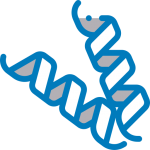
 Beta-Amyloid Abeta1-42 Peptide, HFIP-treated
Beta-Amyloid Abeta1-42 Peptide, HFIP-treated
PE-1749-50
3 vials. 1 x 50 µg Abeta1-42 peptide; 1 x 100 µL Reconstituting Buffer 1 x 1 mL Dilution Buffer
Brand
biosensis
Description
ZZZZ_Status (Active, Disc) : Active
AA_Supplier Name : Biosensis
Alternative_Name (Other Names) :
Beta-APP42; Beta-amyloid protein 42; ABPP; APPI; Amyloid beta A4 protein; AB42; abeta
Antibody_Isotype
(Antibody only) :
Application_Details :
Preparation of unaggregated Aβ1-42:
Important: unaggregated Aβ has to be prepared just prior to use!
1. Add 5 µL of reconstituting buffer to one vial of 50 µg of HFIP-treated Aβ peptide; spin down the liquid briefly
2. Vortex the vial for 5 seconds at highest speed while rotating the vial with your hands; spin down the liquid (bench-top microcentrifuge) and repeat the vortex-spin procedure for a minimum of 3 times; continue the vortex-spin procedure until all lyophilized peptide is dissolved and collected at the bottom of the tube. Important: refer to the attached instructions for a detailed procedure to ensure that all peptide is fully reconstituted!
3. Add 106 µL of cold Dilution Buffer to make up to 111 µL total volume and a peptide concentration of 100 µM. Vortex-spin for 3 more times
4. Final concentration of Aβ is 450 µg/mL
5. Use reconstituted peptide immediately to avoid oligomer formation
Preparation of oligomeric Aβ1-42:
1. Add 5 µL of reconstituting buffer to one vial of 50 µg of HFIP-treated Aβ peptide; spin down the liquid briefly
2. Vortex the vial for 5 seconds at highest speed while rotating the vial with your hands; spin down the liquid (bench-top microcentrifuge) and repeat the vortex-spin procedure for a minimum of 3 times; continue the vortex-spin procedure until all lyophilized peptide is dissolved and collected at the bottom of the tube. Important: refer to the attached instructions for a detailed procedure to ensure that all peptide is fully reconstituted!
3. Add 106 µL of cold Dilution Buffer to make up to 111 µL total volume and a peptide concentration of 100 µM
4. Vortex-spin for 3 more times
5. Incubate the solution at 2-8°C for 24 hours (protected from light)
6. Final concentration of Aβ is 450 µg/mL
7. Once reconstituted and oligomerized, o-Aβ should be used as soon as possible and within 7 days to ensure the stability of the oligomers
Note: while the concentration of monomeric Aβ peptide used to form the oligomeric complexes is accurately determined, the precise formation, size and number of oligomers cannot be quantified by any known method.
Preparation of fibrillar Aβ1-42:
1. Add 5 µL of reconstituting buffer to one vial of 50 µg of HFIP-treated Aβ peptide; spin down the liquid briefly
2. Vortex the vial for 5 seconds at highest speed while rotating the vial with your hands; spin down the liquid (bench-top microcentrifuge) and repeat the vortex-spin procedure for a minimum of 3 times; continue the vortex-spin procedure until all lyophilized peptide is dissolved and collected at the bottom of the tube. Important: refer to the attached instructions for a detailed procedure to ensure that all peptide is fully reconstituted!
3. Add 106 µL of 10 mM HCl to make up to 111 µL total volume and a peptide concentration of 100 µM
4. Vortex-spin for 3 more times
5. Incubate the solution at 37°C for 24 hours (protected from light)
6. Final concentration of Aβ is 450 µg/mL
Preparation of Aβ1-42 Complexes:
Important: only unagreggated Aβ will form complexes. Use Aβ peptide immediately after reconstitution to form complexes.
1. Add 5 µL of reconstituting buffer to one vial of 50 µg of HFIP-treated Aβ peptide; spin down the liquid briefly
2. Vortex the vial for 5 seconds at highest speed while rotating the vial with your hands; spin down the liquid (bench-top microcentrifuge) and repeat the vortex-spin procedure for a minimum of 3 times; continue the vortex-spin procedure until all lyophilized peptide is dissolved and collected at the bottom of the tube. Important: refer to the attached instructions for a detailed procedure to ensure that all peptide is fully reconstituted!
3. Add 106 µL of cold Dilution Buffer to make up to 111 µL total volume and a peptide concentration of 100 µM
4. Vortex-spin for 3 more times
5. Use reconstituted peptide immediately to avoid oligomer formation
6. Mix the Aβ monomer with its complex partner (eg., lipoprotein) at desired concentrations in PBS, pH 7.4, or other suitable buffers compatible with its intended application
7. Incubate at room temperature for 2 hours without shaking
8. Use complexes immediately after incubation
These protocols are based on procedures published by Youmans KL et al., 2012 and Tai LM et al., 2013, and we refer to these publications and other relevant literature for further details.
Provided working concentrations are only meant to guide the user. Optimal concentrations depend on the experimental design and need to be determined empirically.
Background_Info :
Clone_Name
(AB only, monoclonals) :
Datasheet_Link : http://www.biosensis.com/pdf_datasheet.php?products_id=1570
Description (Long Description) :
Synthetic beta-amyloid Aβ1-42 was monomerized by HFIP (hexafluoro-2-propanol) treatment and dried. One vial contains 50 µg monomeric Aβ peptide that can be used to form solutions of unaggregated Aβ monomers, aggregated Aβ oligomers, Aβ fibrils and Aβ protein complexes according to published protocols, and used in a variety of research applications.
Expiry_Date :
Stability of unopened vials is 1 year if stored appropriately.
Format (Form) :
Lyophilized.
Immunogen (Antigen) :
Kit_Components :
MSDS (File name) :
Application
ELISA
Reactivity



